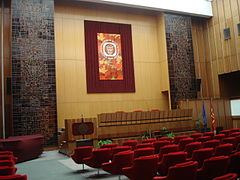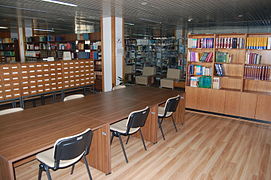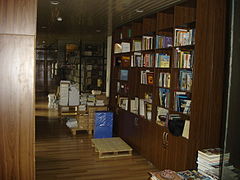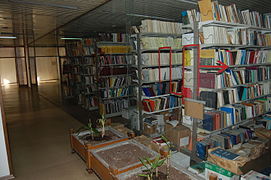Macedonian Academy of Sciences and Arts
This article contains content that is written like an advertisement. (December 2018) |
Македонска академија на науките и уметностите  | |
 The headquarters of the Macedonian Academy of Sciences and Arts | |
| Formation | 22 February 1967[1] |
|---|---|
| Founder | Assembly of North Macedonia |
| Purpose | To monitor and to stimulate the sciences and arts[2] |
| Headquarters | Skopje, North Macedonia |
| Coordinates | 41°59′47″N 21°26′30″E / 41.99639°N 21.44167°ECoordinates: 41°59′47″N 21°26′30″E / 41.99639°N 21.44167°E |
Official language | Macedonian |
President | [3] |
Vice-President | |
Secretary General | Izet Zeqiri |
| Affiliations | ALLEA, UAI, IAP, ICSU |
| Website | www |
The Macedonian Academy of Sciences and Arts (Macedonian: Македонска Академија на Науките и Уметностите, МАНУ) is an important academic institution in North Macedonia.
History[]
The Academy of Sciences and Arts was established by the Socialist Republic of Macedonia's assembly on 23 February 1967 as the highest scientific, scholarly and artistic institution in the country with the aim of monitoring and stimulating the sciences and arts.[4] The Academy's objectives are to survey the cultural heritage and natural resources, to assist in the planning of a national policy regarding the sciences and arts, to stimulate, co-ordinate, organise and conduct scientific and scholarly research and to promote artistic achievement, especially where particularly relevant to North Macedonia. The Academy facilitates scholarly, scientific and artistic endeavour on the part of its members and encourages the use of the most up-to-date methodology and scientific information and the results of the latest research. It also works on developing international co-operation in the fields of the sciences and arts.
As an independent scientific and artistic institution the Academy achieves these objectives by basic, developmental and applied research, comprehensive and inter-disciplinary research projects, by organising scientific and scholarly conferences and symposia, publishing the results of the same and of other scientific research and organising events in the field of the arts. The Academy collaborates with the universities, other scientific, scholarly and cultural institutions, scientific and artistic societies and other comparable organisations in North Macedonia. It also co-operates with other academies of sciences and arts, and with scientific, scholarly and artistic institutions abroad.
Today[]
The Academy's supreme body is the Assembly of all of its members. The Assembly is in charge of passing the statutory regulations regarding the organisation and general activities of the Academy such as its Statute, Financial Plan, the establishment of departments and scientific, scholarly and artistic units, etc. The Assembly elects the President, Vice-President and Secretary of the Academy as well as a number of the members of the Presidency.
It also elects full, foreign and honorary members of the Academy. The election of members takes place every three years by a majority vote in secret ballot of the Academy's full members. The members are independent in their scientific and scholarly research and artistic work and are elected for life. The organisational structure of the Academy includes the Presidency, five departments, five research centres, two technical units and the Academy's Secretariat.
Controversies[]

The Macedonian Encyclopedia is the only scientific encyclopedia of North Macedonia issued in 2009 by MANU. The issuance of the encyclopedia caused a serious protest due to its content, and its authors have been subjected to severe criticism. Such reactions arose in the neighboring Greece, Bulgaria, Kosovo and Albania. It was urgently withdrawn. The reason behind this was political pressure from US and UK diplomats.[7]
In February 2021 the members of the MANU requested that the recent Law proposal for the inclusion of the phrase “North Macedonia” as part of the institution’s name has to be withdrawn. Though, the Macedonian Parliament has agreed. Harsh criticism of the bilateral agreements signed with Bulgaria and Greece there has indicated that this national institution isn't under the direct influence of the government. The head of MANU has called the Prespa Agreement a factor of regional destabilization and the agreement with Bulgaria “demeaning” to the ethnic Macedonians.[8]
Gallery[]
Great conference hall
Sculptures garden, a gift from academician Tome Serafimovski
Laboratory of the Research center of genetic engineering and biotechnology
Reading room of the library
Collection of mineral ores from North Macedonia
Laboratory of the Research center of genetic engineering and biotechnology
Library deposit
Library deposit
See also[]
- Macedonian Encyclopedia - published by the academy
References[]
- ^ "Establishment of MASA". MACEDONIAN ACADEMY OF SCIENCES AND ARTS. Retrieved 2 September 2018.
- ^ "Mission". MACEDONIAN ACADEMY OF SCIENCES AND ARTS. Retrieved 2 September 2018.
- ^ "Leadership – MASA". manu.edu.mk. Retrieved 2 September 2018.
- ^ Vojislav Ilić (1971). Živan Milisavac (ed.). Jugoslovenski književni leksikon [Yugoslav Literary Lexicon] (in Serbo-Croatian). Novi Sad (SAP Vojvodina, SR Serbia): Matica srpska. p. 293.
- ^ Tome Boshevski, Aristotel Tentov, Tracing the script of the Ancient Macedonians. This paper presents the results of research realized within the project "Deciphering the Middle Text of the Rosetta Stone", supported by Macedonian Academy of Sciences and Arts, 2003 – 2005.
- ^ Comparative analysis of the results of deciphering the middle text on the Rosetta stone, Tome Boševski, Aristotel Tentov, MANU, Vol 31, No 1-2 (2010) DOI: https://dx.doi.org/10.20903/csnmbs.masa.2010.31.1-2.23
- ^ Macedonia embroiled in encyclopaedia row. Oct 13, 2009, Euractiv.
- ^ Macedonian Academy of Arts and Sciences says no to “North”. Macedonia Times, February 25, 2021.
External links[]
| Wikimedia Commons has media related to Macedonian Academy of Sciences and Arts. |
- Cultural organizations based in North Macedonia
- National academies of sciences
- National academies of arts and humanities
- Science and technology in North Macedonia
- 1967 establishments in the Socialist Republic of Macedonia
- Organizations established in 1967
- Scientific organizations established in 1967
- Members of the International Council for Science
- Members of the International Science Council








